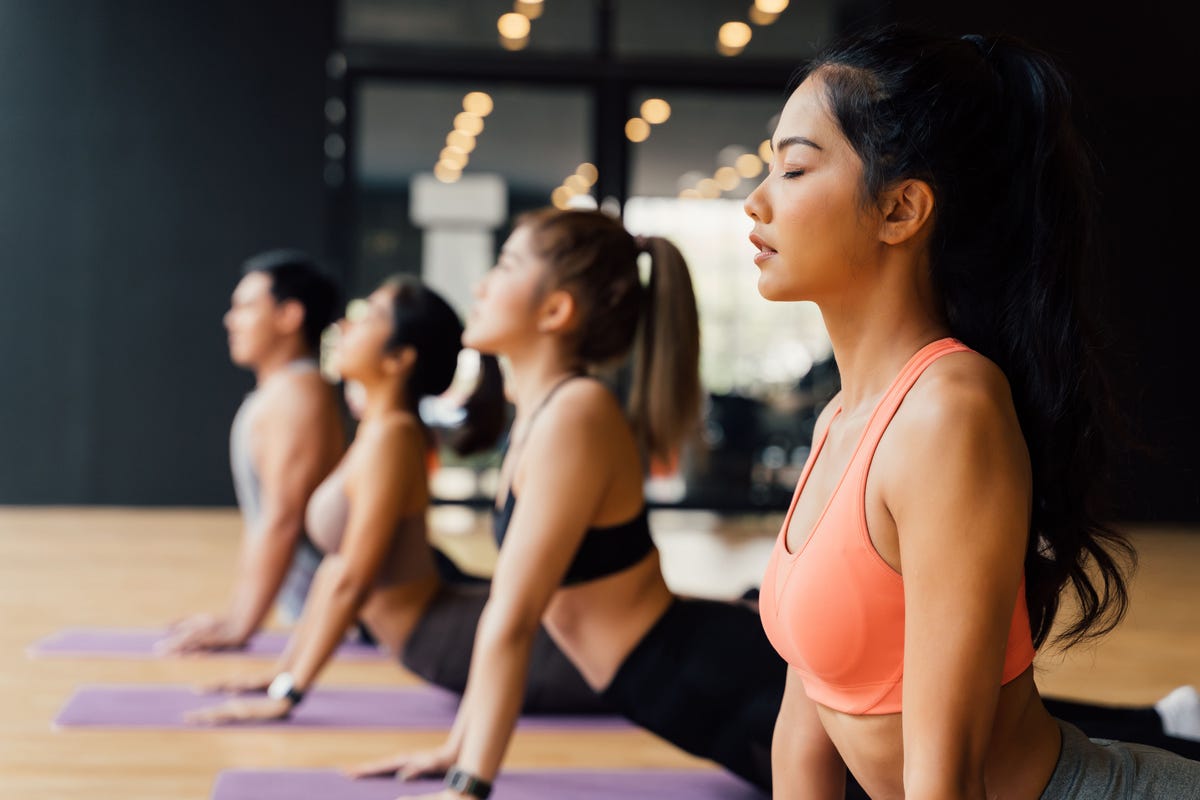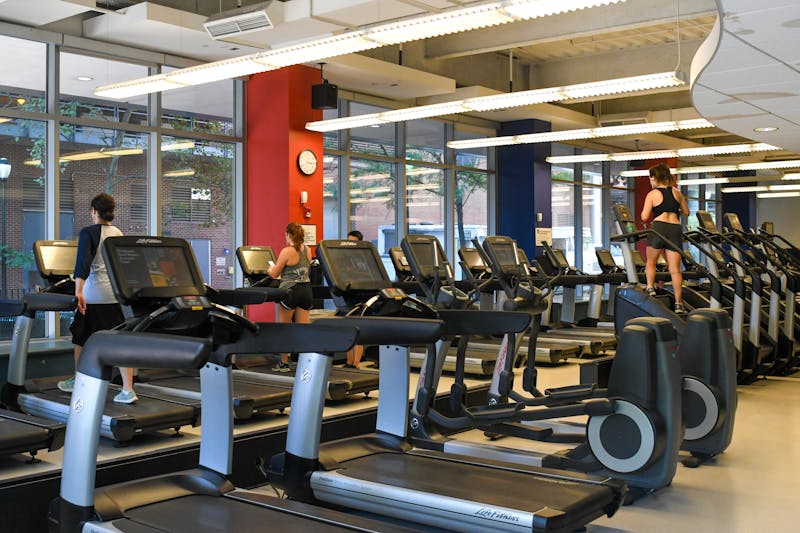Fitness
Short, intense bursts of exercise more effective after stroke than steady, moderate exercise – WorldHealth.net

Significant improvements in aerobic fitness were noted after 12 weeks of high-intensity interval training sessions compared to traditional, moderate exercise sessions, according to a new study in the AHA journal.
News Release Research Highlights:
- Researchers found repeated one-minute bursts of high-intensity interval training (HIIT) were more effective than traditional, moderate continuous exercise for improving the body’s aerobic fitness after a stroke.
- Fitness level improvements doubled in participants in the high-intensity interval training group compared to those in the moderate-intensity exercise group.
- Researchers found the level of fitness changes in the high-intensity interval training group were associated with improved survival and lower risk of stroke-related hospitalizations.
One-minute, short bursts of high-intensity interval training for 19 minutes may be more effective for improving fitness among people six months or more after a stroke than traditional, 20-30 minutes of moderate-intensity exercise sessions, according to research published today in Stroke, the peer-reviewed scientific journal of the American Stroke Association (ASA), a division of the American Heart Association (AHA).
“This study shows that people with stroke can also benefit from high-intensity interval training,” said Kevin Moncion, Ph.D., a physiotherapist who led this study as part of his doctoral studies at McMaster University in Hamilton, Ontario, Canada. “With the right support and guidance, stroke survivors can safely and effectively engage in high-intensity interval training, significantly improving their overall health and recovery.”
The multi-site trial took place between September 2018 and March 2024 and included stroke survivors between six months to 5 years after a stroke. Researchers randomly grouped participants to receive either three days per week of 12 weeks of high-intensity interval training or three days per week of 12 weeks of traditional moderate exercise sessions. The high-intensity interval training protocol involved ten 1-minute intervals of high-intensity exercise, interspersed with nine 1-minute low-intensity intervals, for 19 minutes total. The moderate-intensity continuous training involved 20 to 30 minutes of steady exercise at moderate intensity.
Researchers then compared fitness levels, cardiovascular risk factors such as blood pressure and stiffness of blood vessels, walking speeds, and distances between the two groups. All assessments were repeated one final time 8 weeks after the exercise interventions to evaluate whether the changes were sustained over time.
Researchers found:
- The high-intensity interval training group’s cardiorespiratory fitness levels (rate of oxygen consumed at peak exercise) improved twice as much as the moderate-intensity continuous training group: 3.5 milliliters of oxygen consumed in one minute, per kilogram of body weight (mL/kg/min) compared to 1.7 mL/kg/min.
- The improvement in the high-intensity interval training group stayed above clinically important thresholds even at the 8-week follow-up (1.71 mL/kg/min), whereas the moderate-intensity continuous training group did not (0.67 mL/kg/min).
- Both the high-intensity interval training and moderate-intensity continuous training groups gained improvement in walking endurance, as measured by distance walked over 6 minutes. At baseline, both groups could walk about 355 meters (the approximate distance of three American football fields) over 6 minutes. After 12 weeks of exercise, both groups increased their walking distance by 8 meters and after the 8-week follow-up, they increased their walking distance by 18 meters.
“This is the first randomized trial to examine a time-efficient, high-intensity interval training program to incorporate a phased and progressive approach,” said senior author Ada Tang, Ph.D., a physiotherapist, professor, and assistant dean of Rehabilitation Science at McMaster University. “We also used an adaptive recumbent stepper, which we believe allowed more people to participate in high-intensity interval training, even those who cannot walk fast enough or long enough on a treadmill.”
The limitations of the study include that study participants were higher functioning stroke survivors from a physical standpoint who were at lower risk for heart disease. Study minimum criteria included the ability to walk 10 meters without the physical assistance of another person, although the use of a cane or walker was permitted. Outcome assessments were unblinded at follow-up, which may have influenced results. Lastly, enrollment and exercise for the trial were halted two years for COVID-19 lockdowns, thus inflating the rate of participants who left the study and potentially limiting the statistical power of the analysis.
In 2021, there were 7.44 million deaths attributable to stroke worldwide, according to the American Heart Association’s Heart Disease and Stroke Statistics 2024 Update.
Future research should examine stroke survivors with more severe impairment in physical function or heart disease risk, according to the study authors.
“Stroke rehabilitation professionals now have evidence to support implementing short, high-intensity interval training protocols in clinical practice. We showed our program is safe and effective at improving fitness and walking distance in people after stroke, which are important outcomes for stroke survivors,” Tang said.
Study details and background:
- The study conducted at McGill University in Montreal and McMaster University in Hamilton, Canada included 82 predominantly white adults, (50 men, 32 women), ages 40 to 80. All had mild or minimal disability from a stroke about 1.8 years earlier.
- Participants exercised on adaptive recumbent steppers that allowed for stroke survivors with a wide range of abilities to exercise at high intensities.
- Assessments were done 3 times in total: before starting exercise training (baseline, 0 weeks), immediately after exercise (post, 12 weeks), follow-up 8 weeks after the intervention ended (i.e. 20 weeks from baseline).
- At each assessment, researchers measured cardiovascular health fitness levels, including resting blood pressure, stiffness of arteries, waist-hip ratio (calculated by waist circumference at the belly button and hip circumference at the hip bone), and mobility (walking speed and distance).
- No participants experienced any adverse effects, including feeling tired, shortness of breath, muscle soreness, cramps, or lightheadedness during exercise.
As with anything you read on the internet, this article should not be construed as medical advice; please talk to your doctor or primary care provider before changing your wellness routine. WHN does not agree or disagree with any of the materials posted. This article is not intended to provide a medical diagnosis, recommendation, treatment, or endorsement. Additionally, it is not intended to malign any religion, ethnic group, club, organization, company, individual, or anyone or anything. These statements have not been evaluated by the Food and Drug Administration.
Content may be edited for style and length.
References/Sources/Materials provided by:
This article was written by Karen Astle at the AHA/ASA Newsroom
Karen.Astle@heart.org
http://newsroom.heart.org/news/short-intense-bursts-of-exercise-more-effective-after-stroke-than-steady-moderate-exercise?preview=bb6eef1ad0e95b987cd2f8d2ed5da593
https://www.heart.org
http://dx.doi.org/10.1161/STROKEAHA.124.046564

Fitness
From Diet To Exercise Plan, Know The Secret Behind Jennifer Lopez’s Enviable Physique

Jennifer Lopez, the multi-talented superstar, has always been admired not just for her incredible talent but also for her stunning, age-defying physique. At 54, she continues to captivate audiences with her energy and beauty, prompting many to wonder about the secrets behind her fit and youthful appearance. While there’s no magic formula, J.Lo’s approach to fitness and nutrition offers valuable insights into achieving a strong and healthy body.
The Power of a Consistent Workout Regimen
Strength Training: A Key Component
One of the cornerstones of Jennifer Lopez’s fitness routine is strength training. Rather than relying solely on cardio, Lopez incorporates regular weightlifting sessions into her workout regimen. This combination helps her maintain a toned and sculpted physique while also boosting her metabolism. By lifting weights, she targets various muscle groups, ensuring a well-rounded approach to fitness. Her commitment to strength training is evident in her social media posts, where she frequently shares glimpses of her intense workout sessions.
Personal Training Sessions
Jennifer Lopez doesn’t leave her fitness journey to chance. She works closely with not one, but two personal trainers—Dodd Romero and David Kirsch. These experts help her maintain a rigorous workout schedule, typically training four to five times a week. Each session is tailored to focus on different parts of her body, ensuring a comprehensive workout. From core-strengthening exercises like medicine ball sit-ups to targeted moves like platypus walks, her trainers push her to achieve her fitness goals.
Home Workouts: Making the Most of Every Situation
During the pandemic, like many others, Jennifer had to adapt her fitness routine to the constraints of home workouts. Despite the challenges, she found creative ways to stay active. Alongside her then-fiancé, Alex Rodriguez, Lopez embraced circuit training, which included exercises like kettlebell swings and pushups. This adaptability highlights her dedication to staying fit, no matter the circumstances.
Dance: A Passion That Keeps Her Fit
Dance has always been a significant part of Lopez’s life, and it plays a vital role in her fitness routine. Whether she’s preparing for a performance or simply enjoying a freestyle session, dance keeps her active and engaged. For Jennifer, dancing isn’t just about burning calories; it’s a form of self-expression that enhances her mood and boosts her confidence. By incorporating dance into her weekly routine, she stays fit while doing something she loves.
Also Read: Kylie Jenner Opens Up About Battling Postpartum Depression; How Long Does Postpartum Depression Last?
Rest and Recovery: The Unsung Hero of Fitness
Jennifer Lopez understands the importance of rest in maintaining a healthy lifestyle. Despite her busy schedule, she prioritises getting enough sleep, aiming for eight to ten hours a night. This commitment to rest not only helps her body recover from intense workouts but also ensures she remains mentally and emotionally balanced. Lopez has often emphasised that sleep is crucial for overall well-being, and she makes it a non-negotiable part of her routine.
Jennifer Lopez’s Balanced Diet: Fueling Her Body the Right Way
Protein-Rich Meals: Building and Repairing Muscle
Protein is a crucial element in Lopez’s diet, helping her build and repair muscle after her rigorous workouts. She starts her day with protein-packed egg whites and includes lean meats like turkey, chicken, and grass-fed beef in her meals. Even when dining out, she opts for fish and vegetables, ensuring she maintains her dietary standards. While she enjoys a variety of proteins, she avoids certain options, like salmon, due to personal preferences.
Also Read: Matthew Perry’s Assistant Pleads Guilty For Injecting Him With Ketamine; Ketamine Side Effects to Know About
Moderation and Balance: Enjoying Life’s Pleasures
Despite her disciplined approach to fitness and diet, Jennifer Lopez believes in the importance of balance. She doesn’t deprive herself of her favourite treats, allowing herself to enjoy foods like cookies or fried chicken in moderation. This balanced approach helps her maintain her physique without resorting to extreme dieting or feeling restricted. For Lopez, it’s about finding a sustainable way to enjoy food while staying healthy.
No Vices: A Clean Lifestyle
Lopez’s commitment to a healthy lifestyle extends beyond her diet and exercise. She avoids alcohol, smoking, and even caffeine, all of which can negatively impact the skin and overall health as one ages. By eliminating these vices, she supports her body’s natural ability to stay youthful and vibrant.
Bottomline: Embracing Your Own Fitness Journey
While Jennifer Lopez’s approach to fitness and nutrition is undoubtedly effective, it’s essential to remember that everyone’s body is different. Her routine works for her, but the key takeaway is her commitment to consistency, balance, and self-care. Whether through strength training, dance, or a balanced diet, Lopez has found a formula that keeps her feeling strong, healthy, and confident. Instead of striving to replicate her exact routine, find what works best for your body and lifestyle, and embrace your own fitness journey with the same dedication and passion.
Read Next
Aiming To Master Splits? Here Are 8 Tips That You Should Follow
Fitness
How to Sneak Extra Exercise Into Your Daily Routine

I’m far from the first person to say it, but exercise is essential for our overall health. Exercise helps boost your mood, relieve stress, increase energy, improve sleep quality and lower your risk for developing chronic illnesses and diseases like diabetes, cardiovascular disease and high blood pressure.
You might be wondering, if exercise is so important to our overall health, then why can it be so miserable?
Trust me, I get it. I live an active lifestyle, making an effort to work out daily, and yet I still have that mental debate every morning where I spend several minutes attempting to talk myself out of exercising. Although I never regret working out after the fact, it can be hard to jump the mental hoop. Over the years, I’ve found some easy tricks to get myself more active each day. No, going to the gym and doing a hard-core weight workout isn’t required. There are actually sneaky ways to get more exercise day-to-day that won’t leave you exhausted and miserable. Here’s my secret sauce.
1. Set a routine
OK, so this isn’t really a secret. Creating a regular habit of working out would be ideal — duh! But it’s creating that habit that’s the tricky part. Here’s where I can help.
One of the most efficient ways to build a habit is through the Cue-Routine-Reward system. MIT researchers discovered the power of the neurological loop at the core of every habit. This “habit loop,” later coined by Charles Duhigg in his 2012 book The Power of Habit, consists of three parts: a cue, a routine and a reward.
This system can be applied to building any habit, from drinking more water to waking up earlier. It can certainly apply to creating a workout habit.
For example, say you want to wake up and go to the gym each morning before work. The cue, what triggers the habit, would be the morning and your alarm going off. (Choose a time that works best for you and be consistent. Using multiple cues like time of day and sound can increase your likelihood of performing your routine.)
Your routine, the habit or action you want to create and reinforce, would be getting up and changing into your workout clothes. This can help prevent you from going back to sleep and ensure you hit the gym since you’re already ready. And once you finish the routine (the exercise), you’ll be rewarded. This could appear in the form of endorphins as a bodily reward that can motivate us to do the routine again, or it could even be a tangible reward, like buying yourself new socks after a week of hitting your exercise goals or investing in a new yoga mat after a month of doing yoga each day.
Each person will have a different response to these three elements. It’s important to experiment with what cues and rewards work best for you to develop a consistent routine of training.
2. Start small
A lot of people assume they need to run themselves ragged in the gym to get more fit, but that’s really not true. All you need is about 20 or so minutes a day. The US Department of Health and Human Services recommends a minimum of 150 minutes of moderate aerobic activity a week — that breaks down to a little more than 20 minutes each day. They also recommend strength training to work the major muscle groups at least two times a week.
Thirty minutes of activity each day is an ideal place to start to fulfill your weekly needs, but if that sounds daunting, you can start with even smaller increments. Simply walking on the treadmill or cycling on a stationary bike for five minutes can get you into the habit of exercising a little each day. What you’ll likely find is that those five minutes actually aren’t too brutal, and are maybe even enjoyable. So, the next time you jump on the treadmill, bike or other equipment, you’ll decide to stay for 10 minutes then 15 minutes then 20 minutes, building yourself up bit by bit until you’re getting your heart rate up for 30+ minutes each day.
You can also start with low-impact activity. A brisk walk in the evening is a more-than-sufficient workout. You can also refer to this guide for the best workouts for beginners.
3. Habit stack
Habit stacking, popularized by James Clear in his book Atomic Habits, is a way to create small yet healthy habits. This term might be new to you, but it’s really straightforward: you “stack” the new behavior (exercising) onto a habit you already have to help you remember to do it. This will cause the combo to become a habit.
For instance, if you listen to a podcast every day, try going for a walk while you listen. Waiting for your morning coffee to brew? Try stretching while you wait. Habit stacking can be used in a multitude of ways to make new fitness habits blend into your daily routine.
Exercise while catching up on your favorite podcast.

4. Get active at work
Your workday doesn’t have to be totally sedentary. Rather than using your full lunch hour to eat, take some time to go to the gym, speed walk around the office or run errands. You can also break up the drudgery of the day by taking a walk during one-on-one meetings instead of sitting at a desk or conference room — anything to get up and get moving.
Try to get up every so often to stretch your legs: rather than emailing or Zooming coworkers, get up and talk to them in person if you can; use the stairs rather than the elevator; get up and refill your water every so often.
5. Do exercises you actually like
This is a big one. If you hate exercising, it might be because you aren’t doing workouts you enjoy. Very few people actually enjoy running around in circles for miles. So don’t.
Branch out and try different kinds of workouts until you find one you genuinely enjoy. Biking, surfing, paddle boarding, yoga, hiking, skiing, rock climbing, kayaking and ice skating are all fun activities that get your heart rate up. This will require you to go out of your comfort zone and to be patient as you try things out, but it’ll be worth it when working out no longer feels like a chore.
One trick I used when first getting into working out was using the ClassPass free month trial to try new gyms and classes. The free first-month subscription allows you to visit a particular gym or studio only once throughout the month (you can visit as many times as you want throughout the month after the free trial). This plan is meant to encourage new users to try exercises that might be totally foreign to them, like reformer pilates or hot yoga. During my first month, I tried a boxing class and I was immediately hooked (pun only slightly intended). Now, boxing is one of my favorite ways to incorporate cardio without feeling miserable. I initially felt insecure about trying something so out of my comfort zone, but I felt comfortable within a week and now feel grateful that I found a new activity that I love.
Exercise doesn’t have to feel like a chore.

6. Get active while watching TV
Let’s be honest, running on the treadmill is boring. Riding on a stationary bike is boring. Watching TV is way more fun. That’s why you should combine the two.
There’s no shame in catching up on your favorite show while hitting the gym. Trust me, I’ve been rewatching Game of Thrones on my phone while riding on the stationary bike each day. Not only does the entertainment keep my mind off the burn in my legs, but it pushes me to stay longer. Before downloading Netflix and HBO Max on my phone, I’d stay at the gym for 20 to 30 minutes. Now, I usually stay on the bike or treadmill for 50 to 60 minutes — until the episode is over.
7. Make it social
Exercise doesn’t need to be solitary. Having a workout partner can help keep you motivated and hold you accountable in your routine. If you don’t have one buddy to join you, sign up for a workout class. The structure of working out in a group can push you to work harder while also introducing you to new people.
Workout classes can hold you accountable — and introduce you to new people.

I recommend exploring the fitness course schedule at your local YMCA or gym, signing up for a boxing, dance or yoga class or purchasing a ClassPass membership, which can grant you access to thousands of health clubs in your city.
For more ways to improve your everyday health, here are 12 household items that double as gym equipment and daily habits to boost your mental health.
More fitness tips
Fitness
Nargis Fakhri Focuses On Muscle Building With A Kettlebell Workout; Here’s Why You Should Do It Too

Nargis Fakhri, known for her roles in Bollywood, has recently captured attention not just for her acting but also for her dedication to fitness. The actress has embraced a rigorous workout regime, emphasising the importance of muscle building, particularly for women. Through her social media, Nargis shared insights into her fitness journey, focusing on kettlebell workouts, which have become a central part of her routine. Her message was clear: prioritising health is vital for a strong body, mind, and soul.
Nargis Fakhri’s Fitness Mantra: Health is True Wealth
In a recent Instagram post, Nargis Fakhri showcased her commitment to staying fit by sharing a series of photos where she is seen engaging in a kettlebell workout. Dressed in stylish sage-coloured workout attire, she held a kettlebell with confidence, radiating both strength and grace. Her caption highlighted the significance of muscle building, especially for women, emphasizing that consistency in workouts is essential for long-term health. “Muscle building is important for longevity, especially for women. It’s crucial to make time every day to invest in your future,” Nargis wrote, further stating, “Health is the one and only TRUE WEALTH!”
This message, paired with her powerful images, serves as a reminder of the importance of investing in one’s health, not just for aesthetic reasons, but for overall well-being and longevity.
The Power of Kettlebell Workouts
Kettlebell workouts have gained popularity for good reason. Unlike traditional weights, kettlebells have a unique shape that allows for a dynamic range of movements. The centre of gravity in a kettlebell is displaced from the handle, enabling a wide variety of exercises that can be performed with one or both hands. This design allows for ballistic exercises, swings, and more, making it an incredibly versatile tool for strength training.
Why You Should Incorporate Kettlebell Workouts Into Your Routine
Kettlebell workouts are not just a fad; they offer a multitude of benefits that can help you achieve your fitness goals. Here’s why you should consider adding them to your routine:
Also Read: Get Fit Like Blake Lively: Unveiling the Workout Secrets of the It Ends With Us Star
Full-Body Engagement
Kettlebell exercises target multiple muscle groups simultaneously. Whether you’re performing a swing, a snatch, or a press, your body works as a cohesive unit. This not only helps in building muscle but also improves coordination and balance.
Efficiency
Time is often a limiting factor in our busy lives. Kettlebell workouts allow you to maximize your time in the gym. Because they engage multiple muscle groups at once, you can achieve a comprehensive workout in a shorter period.
Strength and Power Development
The dynamic nature of kettlebell exercises helps in building explosive strength and power. Movements like the kettlebell swing generate power from your hips, engaging your core and lower body, which is essential for overall strength.
Improved Flexibility and Mobility
Many kettlebell exercises, such as the Turkish get-up, require a full range of motion. This helps in improving flexibility and mobility, which are crucial for maintaining functional fitness and preventing injuries.
Also Read: Vampire Diaries Fame Nina Dobrev Opens Up About Her Stricter Than Ever Skincare Routine
Cardiovascular Benefits
Kettlebell workouts are not just about building muscle. The intensity of the exercises also provides a cardiovascular challenge, making it a great way to improve heart health while building strength.
Adaptability
Whether you are a beginner or an advanced fitness enthusiast, kettlebell workouts can be adapted to suit your level. You can start with lighter weights and progress as you build strength and confidence.
A Lesson from Nargis Fakhri’s Fitness Journey
Nargis Fakhri’s dedication to her fitness journey is inspiring for anyone looking to improve their health. Her focus on muscle building, particularly through kettlebell workouts, highlights the importance of incorporating strength training into our daily routines. It’s not just about building muscles; it’s about building a healthier, stronger, and more resilient body.
As Nargis puts it, “Health is the one and only TRUE WEALTH.” This statement resonates deeply in a world where we often overlook our health in the pursuit of other goals. By dedicating time each day to our fitness, we invest in our future, ensuring that we remain strong, healthy, and capable for years to come.
Bottomline
If you’re looking for a workout that offers a blend of strength, endurance, and flexibility, consider adding kettlebell exercises to your fitness regimen. Not only will you see physical improvements, but you’ll also experience the mental and emotional benefits of a consistent, challenging workout. Just like Nargis, you too can achieve a balanced, healthy lifestyle through the power of kettlebell training.
Read Next
Leg Presses Vs Squats: Expert Explains Which Is Better For Building Lower Body Strength And Burning Calories?
-

 Minnesota1 week ago
Minnesota1 week agoReaders and writers: Plenty of thrills and danger in these Minnesota author’s mysteries
-

 Fitness1 week ago
Fitness1 week agoA Guide to Pottruck Health and Fitness Center
-

 Technology3 days ago
Technology3 days agoBreakthrough robo-glove gives you superhuman grip
-

 Politics1 week ago
Politics1 week agoTrump assassination attempt: Secret Service makes big change to former president's outdoor rally security
-

 News1 week ago
News1 week agoVideo: Biden and Harris Announce Deal to Lower Drug Prices
-

 Politics1 week ago
Politics1 week agoYoungkin takes victory lap against 'losing states' as Virginia marks $1B surplus: 'The playbook works'
-

 News1 week ago
News1 week agoOver 100 of Donald Trump’s companies make no money: Financial disclosures
-

 Politics1 week ago
Politics1 week agoHouse Oversight investigating Walz over 'longstanding connections' to China














